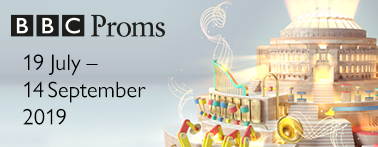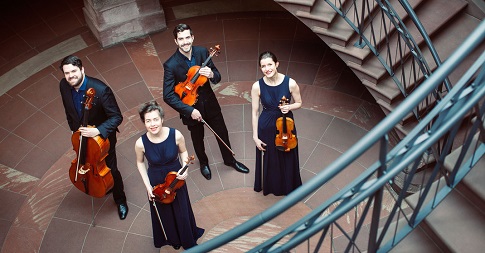
 United Kingdom BBCS Proms at … Cadogan Hall 4 – Schubert, Maddalena Laura Sirmen, Haydn: Aris Quartet (Anna Katharina Wildermuth & Noémi Zipperling [violin], Caspar Vinzens [viola], Lukas Sieber [violoncello]), Cadogan Hall, London, 12.8.2019. (CS)
United Kingdom BBCS Proms at … Cadogan Hall 4 – Schubert, Maddalena Laura Sirmen, Haydn: Aris Quartet (Anna Katharina Wildermuth & Noémi Zipperling [violin], Caspar Vinzens [viola], Lukas Sieber [violoncello]), Cadogan Hall, London, 12.8.2019. (CS)

Schubert – String Quartet No.1 in G minor/Bb major D18
Maddalena Laura Sirmen – String Quartet No.5 in F minor
Haydn – String Quartet in B flat major Op.76 No.4, ‘Sunrise’
The Aris Quartet were formed in 2009 at the University of Music in Frankfurt. Since then they’ve won many awards in Germany and Austria, and they were named BBC New Generation Artists in 2018. This performance at Cadogan Hall, their Proms debut, was the first time that I had had the opportunity to hear the Quartet perform and the overriding impression I had was of four musicians who had prepared meticulously and who play with precision, care and well-balanced accord. Their programme of quartets from Classical Vienna and Venice seemed perfectly attuned to their temperament – though their encore suggested that there is perhaps more fire in their spirit than was evident in the main body of the programme.
The Aris Quartet began with a quartet that Schubert wrote when he was just 13 years-old; one could surely hear the young viola player-composer experimenting with harmonic excursions and textural innovations. The Aris brought forth the melancholic accentuations of the opening Andante, which was more haunted than questing, though the full chords were vigorously articulated and the Presto vivace, which transforms the Andante’s scalic arc into an urgent, anxious motif, took off with purpose and forward thrust. The staccatos – runs and chords – were exaggeratedly spiky, presumably deliberately, though the Cadogan Hall acoustic is not as sympathetic as, say, Wigmore Hall. Cadential chords were full and rich, though not always perfectly tuned.
The Menuetto was gracious and refined: leader Anna Katharina Wildermuth’s sensitive song was accompanied by delicately dancing arpeggios from Noémi Zipperling, warm viola ‘filling’ from Caspar Vinzens, the upper voices gently directed by Lukas Sieber’s cello. This was the epitome of Viennese Classical grace – the adolescent Schubert doing his best to imitate Papa Haydn. The Andante moved forward persuasively, and once again we could enjoy Wildermuth’s lovely tone and silky legato. The Presto raced at quite a lick, and again the articulation of the staccato runs and semiquavers – quasi-tremolos – was a little ‘hard’, but the Aris derived energy from the imitation, dynamic contrasts and weak beat accents. A culminating fugue seemed inevitable, and Schubert and the Aris Quartet duly delivered a rousing conclusion.
Each Proms at … Cadogan Hall this season features at least one work by a female composer. On this occasion the spotlight shone on Maddalena Laura Sirmen (née Lombardini, c.1745-1818), an eminent violinist, singer and composer who was taught by Tartini. When she came to critical notice, her musical inheritance was recognised, one Quirino Gasparini writing: ‘She won the hearts of all the people of Turin with her playing … I wrote to old Tartini last Saturday telling him the good news. It will make him all the happier, since this student of his plays his violin compositions with such perfection that it is obvious she is his descendant.’
Sirmen’s string quartets were written fairly early in her life and published in Paris in the late 1760s by Vénier, under the joint authorship of Maddalena and her husband, the renowned violinist Ludovico Sirmen. Leopold Mozart seems to have been impressed by her work, writing to Wolfgang that he had ‘attended a concert where ‘Count Cernin played a beautifully written concerto by Syrmen …’
The Fifth Quartet’s main claim to originality is the rather unusual movement structure: in fact, one might describe it as a single movement work in which the opening Largo, somewhat severe and stark, opens out into a sunny Allegro which transforms the Largo’s theme, only for this happy diversion to be interrupted by the return of the Largo which serves as a ‘cool’ prelude – played here with minimal vibrato – to the final, motivically linked, Menuetto. There were some interesting features to note: the close intertwining of the voices, within a restricted tessitura; some interesting harmonic ‘interruptions’; the use of paired instruments in sparse textural arrangements. But, overall, though the Aris Quartet worked hard to make the music ‘communicate’, Sirmen’s Fifth Quartet felt quite lightweight: a sort of Boccherini meets Chevalier de Saint-Georges divertissement.
Haydn’s Op.76 No.4 Quartet, the ‘Sunrise’, brought gravity and substance to the Cadogan Hall. The first violin’s upward curl at the start of the Allegro con spirito was beautifully phrased, and the Aris Quartet displayed sensitivity to the harmonic nuances balanced by robustness in the more dynamic and energetic passagework. Bright sforzandos, springy syncopations, lithe semiquavers oscillations, and quite gruff and dry spiccatos (again) contributed to the vibrancy of the overall soundscape. At the start of the Development section there was a welcome spaciousness, with the move to the minor tonality, before the theme was grabbed by the scruff of its neck and subjected, in a short space of time, to busy development, transformation and translation. The Recapitulation brought relief, and the climbing coils concluded with much more emphatic cadences. The was a searching quality as the material was reprised and varied, and a sense of confidence was communicated when it found its true path.
The following Adagio had a lovely reedy quality at the start – like a squeeze box, with juicy swells – which contrasted subsequently with a transparency facilitating dialogue between the first violin and cello, always pushing forward. The Menuetto possessed delightful grace: but just as one felt as if one might be whisked off one’s feet, the Aris truncated the dream with a robust, realistic stamp! – and such rustic honesty created continuity into the drone and thigh-slapping of the Trio. To my ears the final Allegro, ma non troppo felt too agitated: there was too much intervention – dynamic, textural – in a theme which should surely unfold sweetly, like a song. The minor key variation was quite intense, but with the restatement of the original theme there was a gradual and compelling increase of tempo, leading to a Più Allegro which swept all along in its wake.
The Aris Quartet’s encore was the Finale: vivace ma non troppo of Dvořák’s ‘American’ Quartet. It was skilfully and expressively played, and presumably designed to display a wider expressive palette, but somewhat at odds with the spirit of the preceding concert. Nevertheless, it did make me want to hear the Aris Quartet again, especially in repertoire that takes a step from the eighteenth century into less genteel worlds.
Claire Seymour